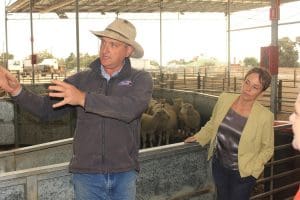
Hamilton Stock Agents Association president Bernie Grant explains the Hamilton Draft system to Minister for Agriculture Jaala Pulford.
VICTORIA’S sheep and goat saleyards and processing facilities will have higher electronic tag-reading standards imposed on them next year.
Minister for Agriculture Jaala Pulford announced today that action and performance levels for Victorian sheep and goat saleyards and processing facilities will be increased from 80 to 90 percent from 31 March next year.
The Andrews Labor Government said it is boosting traceability standards to protect Victoria’s $6.7 billion livestock industry. Levels were originally set at 80pc to facilitate a smooth transition for industry to the new electronic National Livestock Identification System for sheep and goats, assisted by a $17 million transition package.
The government said most saleyards and processors are already achieving read rates close to 100pc of the electronic NLIS tags on sheep and goats, so the impact of raising these levels is expected to be minimal.
Chair of the Sheep and Goat Identification Advisory Committee Stuart McLean said increasing action levels for saleyards and processors on the 31st March 2019 will be very attainable by the industry, particularly with six months to prepare and plan for these changes.
The government said the industry has embraced the new system, with scanning infrastructure and software installed in all sheep selling saleyards and processing plants, supported by the Labor Government’s $17 million transition package.
The phased implementation of electronic identification, supported by the Sheep and Goat Identification Advisory Committee, has allowed saleyards, agents and processors to adapt without major disruption to established practices, the government said.
Victoria is the first state in Australia to introduce mandatory electronic identification for sheep and goats, which will provide trading partners with increased confidence in the safety and origin of Victorian products – protecting and enhancing access to expanding and profitable local and export markets.
The Labor Government said it will continue to support saleyards and processors through the transition.
Ms Pulford said Victoria’s sheep and goat industries have embraced the transition to electronic identification and are exceeding current action and performance levels.
“That’s why we’re lifting them.
“Most saleyards and abattoirs are already reading close to 100 percent of the electronic NLIS tags on sheep and goats, so the impact of raising these levels is expected to be minimal,” she said.
“Victoria is leading the way with this critical reform and our sheep and goat industries should be commended for the way in which they have embraced the change and made a successful transition to the electronic system.”

This is totally irresponsible legislation introduced by Jaala Pulford and a total waste of taxpayers’ funds.
The cattle NLIS database is in an absolute shambles. The Agribusiness Online audit conducted on 57,000 tags tracing the movements of cattle from 17 Producer Identification Codes showed that over 34 percent of cattle had lost their whole of life traceability at the time of slaughter. The claims made by the Victorian government are inaccurate and misleading on the benefits of radio frequency identification (RFID). Last month alone, I received five warnings of lots of cattle that were sold off my PIC. I have not sold any cattle for 12 months and a head count shows that none have been stolen?